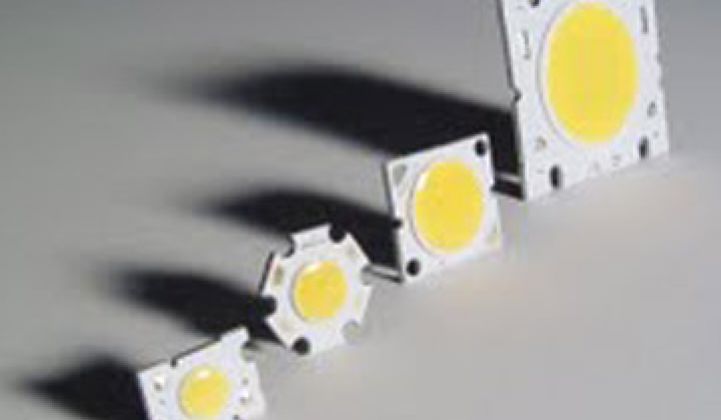Bridgelux CEO Bill Watkins was talking to a group of reporters about the future of light-emitting diodes (LEDs) and brought along a few for demonstration purposes.
And strangely enough, there was a classic household (A19) bulb in the mix.
The company, he stated, will sell LEDs and other components to light bulb makers for the residential lighting market. Until now, Bridgelux has largely concentrated on lighting modules -- which consist of LEDs, drivers and the other electronics necessary for producing a light fixture -- for commercial lighting, like the Helieon light module pictured in this article.
Residential lighting, however, is taking off rapidly, he said. Homeowners also don’t need to retrofit their houses to accommodate LED bulbs. They just screw them into sockets. In commercial buildings, light fixtures often have to be switched to accommodate an LED lamp. Although commercial customers can see greater savings with LEDs because they have more light fixtures and benefit from lower maintenance, the infrastructure issue can’t be ignored.
Other things on his mind:
--Household LED bulbs now sell for around $20 or less and it won’t be long before we see $10 LED bulbs. When that happens, the market will explode. CFL manufacturers tell him that the growth spurt for them happened at the $10 mark.
--Ikea is really interested in marketing and selling LED bulbs. (Sneevark: 3 for $10!) Stay tuned.
--China is coming on strong in LED lighting and is aggressively recruiting U.S.-based LED companies to build factories there. The number of LED makers is mushrooming and provincial officials are more than happy to show off vacant office and factory space to visiting U.S. executives.
--Samsung and LG are also bonkers for LEDs. A different source told us that Samsung has ordered as much equipment for LED as has the whole industry combined in recent months.
Like MiaSole’s Joseph Laia, Watkins says he would love to keep factories in the U.S., but doing so would mean putting his company at a cost disadvantage.
--There is a way to bring LED manufacturing to the U.S., he suggested. The Department of Energy, state governments and/or even cities could set up programs to subsidize the cost of LED bulbs, arguably similar to how solar panels get subsidized today. The payoff would come in reduced energy consumption. (Some companies like Metrus Energy and Skyline Innovations are already talking about selling lighting as a service: the new fixtures get paid for through lower bills.)
But, as part of the provision, Watkins would suggest only allowing bulbs with 60 percent of their content from the U.S. qualify for subsidies.
Other countries are doing the same thing to promote local manufacturing, he noted. (‘Buy American’ provisions have prompted Chinese solar companies to build module facilities in the U.S.) The only thing stopping us is our love of the theory of free trade.
--Bridgelux is working on silicon-based LEDs. Right now, LEDs get made on sapphire substrates. The sapphires aren’t like the ones you see at Zales. They are large, factory-produced blobs that vaguely resemble Jabba the Hut. But factory sapphire is still expensive.
Silicon would drastically cut the cost of LEDs, but there is a catch -- silicon does not generate light well. Intel, IBM and others have wrestled with generating light from silicon for years; the idea is to conduct signals in chips via light instead of electrical signals to curb power, reduce heat and improve performance. A lot of these companies published papers on silicon photonics back in 2001, and commercialization still hasn’t occurred. Nonetheless, progress is underway on this front, so keep your eyes peeled.
--Bridgelux is also working on LEDs that can accommodate AC power. Right now, LED light fixtures convert incoming AC power to DC before light gets produced. By eliminating a conversion, Bridgelux could further conserve power.
Other companies are working on lighting systems that eliminate conversions by running DC power in buildings.
I wanted to peg Watkins more on the AC idea but I had to take notes on a napkin. There's your transparency-in-media moment for the day.



